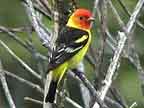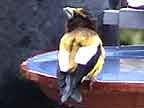Wings & Things
Some of the questions you ask when identifying a new bird are: How far do the wingtips extend? Are the wings short, long, pointed or rounded? What is the color? Are there wingbars or wing patches? If so, how many? What color are they?
The presence of wing markings gives positive identification even when the bird is in a non-breeding plumage. This is particularly true with warblers and vireos. However, in other groups, the absence of wing markings is an important characteristic; for example, in flycatchers and sparrows.
Wingbars
Wingbars are lines across the wing contrasting in color with the rest of the wing. A long and fairly wide wing bar may be called a 'wing stripe.'
The warbler family is divided between those that have wingbars and those that don't. So if you see a warbler-like bird, quickly look for wingbars.
Wing Patches
Wing patches are large areas of color. In the photo below, the large white area on the Evening Grosbeak's wings provide a good identification of wing patches.
Wingtips
Wingtips are another identification clue that is very useful. For example, the Costa's and Anna's Hummingbirds are very similar. When the wingtips project just beyond the tail tip, you are looking at a Costa's Hummingbird rather than an Anna's Hummingbird.
Factoid: The air from a bird's lungs fill their hollow bones. (Have you noticed wishbones are hollow?) Birds pull themselves forward through the air as though rowing a boat. With the broad side of the wing, the air is pushed down and back. By slightly turning the wing and folding it, they move forward. Birds with huge broad wings soar and glide easily for hours while the birds with short wings need to flap consistently to stay a flight.


